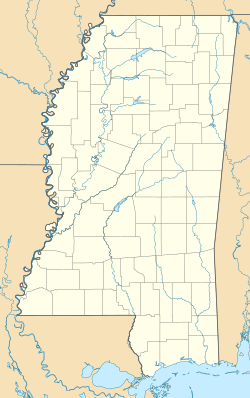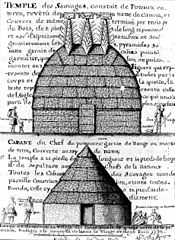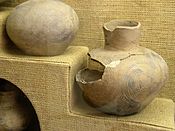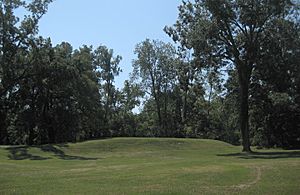Grand Village of the Natchez facts for kids
|
Grand Village of the Natchez
|
|
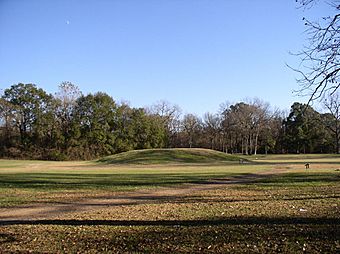
Main mound at the Grand Village of the Natchez Site in Natchez, Mississippi
|
|
| Nearest city | 400 Jefferson Davis Boulevard, Natchez, Mississippi |
|---|---|
| NRHP reference No. | 66000408 |
Quick facts for kids Significant dates |
|
| Added to NRHP | October 15, 1966 |
| Designated NHL | July 19, 1964 |
The Grand Village of the Natchez, also known as the Fatherland Site, is a special place in Natchez, Mississippi. It covers about 128 acres (52 hectares). This site was once a large village with big earth mounds built by ancient people.
The first people to build here were part of the Plaquemine culture. They started building around the year 1200. They created three large platform mounds, which are like flat-topped hills. More building work happened in the mid-1400s.
Later, in the 1600s and 1700s, the historic Natchez people used this village. It became their most important place for meetings and religious ceremonies. They even added to the mounds.
Sadly, after a fight with French settlers in 1730, the Natchez people left the village. In the 1800s, the land became part of a farm called Fatherland Plantation. People started digging and studying the site in 1930. They found the three mounds, which had been partly covered by soil over time.
Today, the Grand Village of the Natchez is a very important historical site. It was named a National Historic Landmark in 1964 and a Mississippi Landmark in 1985. You can visit it as part of the Mississippi Mound Trail.
Contents
History of the Grand Village
Early Builders: The Plaquemine Culture
Building at the Grand Village started around 1200. This was during a time called the Anna phase of the Plaquemine culture. Workers carried all the soil for the mounds by hand, probably in woven baskets. They were skilled at using different types of soil to make the mounds strong.
More building happened in the mid-1400s, during the Emerald phase of the Plaquemine culture. The site had three special platform mounds used for important events.
The Natchez People's Home
Between 1682 and 1729, the Natchez people used this village as their main center. French visitors at the time wrote about it. The three mounds were very important for their religious and political ceremonies.
Researchers first called the mounds A, B, and C. Now they are known as Abandoned Mound, Sun Mound, and Temple Mound. The Sun and Temple Mounds have been carefully dug up and rebuilt to look like they did long ago. The Abandoned Mound has not been rebuilt.
From 1700 to 1730, the Natchez added more to the Sun Mound (Mound B) and Temple Mound (Mound C). On top of the Sun Mound, they built the home of the Great Sun. The Great Sun was the main leader of the tribe.
The Temple Mound (Mound C) held the Sun Temple. This temple was a special building where the remains of important Natchez leaders were kept. By the time Europeans arrived, the Natchez were no longer using the Abandoned Mound (Mound A).
Most Natchez people lived in smaller villages nearby. They would gather at the Grand Village for big events. They were farmers and built permanent homes.
Life with French Settlers
During this time, French settlers came to the area. They started building their own towns, which slowly took over Natchez land. At first, everyone got along. But soon, the French colonists started using up the resources the Natchez needed to live.
There were some fights in 1716 and 1723, which caused problems. The Natchez gave some land to the French to try and keep the peace.
In 1728, the Great Sun died, which caused some trouble within the tribe. His replacement, the Young Sun, was not as friendly with the French. The Natchez also got caught between the French and British, who were rivals in the region. Both countries wanted to trade with the Natchez.
In 1729, a group of Natchez who favored the British attacked French settlements. The French fought back with their Native American allies. They forced the Natchez out of the area. Some Natchez people escaped and found safety with other tribes, like the Creek and Cherokee. After the French sold 300 Natchez survivors into slavery, the Natchez people "ceased to exist as a cultural group" in their traditional homeland.
Modern Discoveries and Restoration
In the late 1800s, researchers named the mounds after the Fatherland Plantation. This farm had been built on much of the site earlier that century. Later, when researchers realized this was the "Grand Village of the Natchez" mentioned in old French records, they changed the name to honor the Natchez people.
Archaeologists have studied the site many times. They dug here in 1930, 1962, and 1972. Based on what they found, the state of Mississippi rebuilt the Sun Mound and Temple Mound to their original sizes. Other groups, like the National Park Service and several universities, continue to study the site.
Today, the Grand Village is a popular place for visitors in Natchez. The state of Mississippi manages the property. It has a museum with many artifacts found at the site. You can see pottery from the Plaquemine culture and baskets made by local tribes. There's also a rebuilt Natchez house, picnic areas, and nature trails. The mound area has been partly restored for everyone to see.
See also


